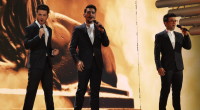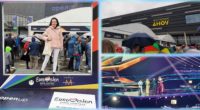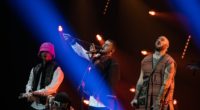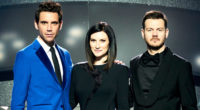
Spain just finished their second heat of Destino Eurovisión in the search for who can represent Spain at the 2011 Eurovision Song Contest. Out of the 12 acts presented, Esmeralda Grao, Melissa, Sebas, Mónica Guech and Don Johnsons managed to convince the jury and audience enough to advance to the national semi-final.
The show was phenomenal, with energy, great voices and great dance moves. Like last week, twelve artists fought for five places in the semi-final and they performed their own versions of hits of the history of the Eurovision Song Contest to try to convince the jury and the audience to vote for them.
After a fast introduction of the five-member expert jury composed by the singers and songwriters Albert Hammond, David Ascanio and Merche, Eurovision Song Contest expert Reyes del Amor and popular television personality Boris Izaguirre, the show started.
The songs: (read more about the participants in our presentation)
Song number 1: Pau Quero – A ba ni bi (performed by Izhar Cohen and Alphabeta in the 1978 Eurovision Song Contest representing Israel)
He looked very happy on the stage. He was really enjoying his performance. He had choosen the Spanish version of the song that is an up-tempo disco number. He was wearing white trousers, a blue jacket and red shirt. He was flanked by four dancers, two boys dressed in black and two girls with black and white shirts and shorts, and the song was accompanied by an amazing dance routine. On the LED screens in the background, we could watch some images of A ba ni bi‘s perform in the 1978 Eurovision Song Contest. The jury criticised the beginning of the song (sang out of tune) but they said the end of the song was much better.
Song number 2: Lorena Rosales – My Number One (performed by Helena Paparizou in the 2005 Eurovision Song Contest representing Greece)
The performance with the most rhythm of the night. A powerful voice and good looking, but somehow the performance lacked the energy of the original one. Lorena was dressed in a pink dress. On the stage there are five dancers dancing a surprising choreography with flashlights. On the LED screens in the background, we saw some images of Helena Paparizou’s perform in the 2005 Eurovision Song Contest. The jury seemed to like Lorena’s performance.
Song number 3: Don Johnsons – Yo Soy Aquel (performed by Raphael in the 1966 Eurovision Song Contest representing Spain)
They are four guys who had transformed Raphael’s ballad into a strong rock song performing a sexy and saucy version of this tune. The band has one singer, two on guitars and one on drums. All of them are both confident and comfortable on stage. Their look gives the song a rock and roll feeling. The lead singer has very strong vocals and sang this ballad in a rock style. He was dressed with black trousers and white shirt and jacket and the other members of the band also wore black and white casual clothes. The performance went down very well with the audience from the beginning to the end. The jury congratulated them for their performance but they advised them to continue to improving their vocal technique.
Song number 4: Sergi Albert – Hold Me Now (performed by Johnny Logan in the 1987 Eurovision Song Contest representing Ireland)
He had a deep voice, one of the best male voices of the night, and really emphasised his low notes. He was not only singing but he also was living and feeling what he said (with a pretty good pronunciation, by the way). This is his style but I think he will have some difficulties singing other kind of songs. On the LED screens in the background, we watched some images of Johnny Logan’s perform in the 1987 Eurovision Song Contest. He wore black trousers, white shirt, a jacket and a grey tie. Halfway through the performance, three backing singers, dressed in black, appeared on the stage and stood behind him. The jury said that he has a beautiful voice and a great presence on the stage due to his experience as a musical actor.
Song number 5: Mónica Guech – Believe (performed by Dima Bilan in the 2008 Eurovision Song Contest representing Russia)
She chose the Spanish version of the song, with some parts of the original one in English. She gave her personal touch to the song with a style reminiscent of soul. She started her performance playing the piano and when she stood up, at the end of the song, she transmitted a boundless energy. Her voice was perfectly tuned to the needs of this song and her laughter would melt the ice off of the coldest heart. On the LED screens in the background, we saw some images of Dima Bilan’s perform in the 2008 Eurovision Song Contest. She was dressed in a simple black dress. The orchestra accompanied her from the back of the stage. The jury talked her about how lucky piano-playing women have been in the Eurovision Song Contest.
Song number 6: Alazán – Bandido (performed by Azúcar Moreno in the 1990 Eurovision Song Contest representing Spain)
They danced exactly the same dance routine that her aunts, Azúcar Moreno, did when they performed the song in the Eurovision Song Contest. They dressed in similar black and bright dresses and they also wore very sexy stockings. Two men dancers were on the stage dancing behind them. Their version was very similar to the original one, so much so that, when you looked the Azucar Moreno’s performance at the LED screen it was like a mirror but their vocals were not as strong as those of her aunts. The jury criticised that they were out of tune.
Song number 7: Sebas – Molitva (performed by Marija Šerifovic in the 2007 Eurovision Song Contest representing Serbia)
Do not forget that he is a huge Eurofan and he was able to show his love for the Eurovision Song Contest with his performance. He sang a Spanish version of the song. He seemed very comfortable with the song but he looked a little bit nervous, and his voice was too fragile at times. His voice garbled a little and went slightly out of tune. He wore a black suit and red shirt. He was accompanied by five backing dancers, dressed in black, who appeared in the middle of the performance. He ended his performance dropping to his knees. During the jury valoration, everyone in the audience was cheering loudly at him.
Song number 8: Melissa – Aprés toi (performed by Vicky Leandros in the 1972 Eurovision Song Contest representing Luxembourg)
She has a great voice. In this version of the song, Melissa sang part in French and other part in Spanish. She portrayed the emotion and feeling of the song through her voice and expressions. Actually, her voice fitted the song and the genre so well. She was vocally pure and was able to accent all of the difficult nuances the song has. It was very well done. She wore a white skirt with feathers and there also were five backing singers on the stage dressed in black. On the LED screens in the background, we saw images of Vicky Leandros perform in the 1972 Eurovision Song Contest. The jury told her that she had done a fantastic performance and they distinguished the power of her gaze in front of the camera.
Song number 9: Sometimes – Waterloo (performed by Abba in the 1974 Eurovision Song Contest representing Sweden)
It was an amazing performance. A capella singing, without instruments, is very risky bet but very original. This young vocal band was composed by five men singers who had performed an a capella version of Abba’s Waterloo that sounded spectacular. The true splendour of their voices singing a capella was found in the way they blend their voices into magical notes. They were five brilliant voices creating the most lovely formulation of pure, authentic and heavenly sounds. Truly, the magnificence of their voices coming together in perfect harmony thrills and touched the very soul. They were dressed alike, wearing black trousers, shirt and jacket, and some of them wore red belt and red shoes. The jury told them that they were very brave making this version of which is considered the best song of the Eurovision Song Contest’s history.
Song number 10: Valeria Antonella – Kisses For Me (performed by Brotherhood of Man in the 1976 Eurovision Song Contest representing the United Kingdom)
She has a naive style of singing and a childlike voice that charmed the audience. Her sweet voice reflected the innocence of the original song but she was the whole song out of tune. There were four dancers with her on the stage. On the LED screens in the background, we could watch some images of Brotherhood of Man’s perform in the 1976 Eurovision Song Contest. She was dressed in a sexy pink dress and she wore an original headdress like a hat. The jury said that she should work on the tune of her voice.
Song number 11: WE – Enséñame A Cantar (performed by Micky in the 1977 Eurovision Song Contest representing Spain)
The name of the group is actually the initials of two of its members’ favourite artists: Whitney Houston and Elvis Presley and, when they sing, they are quite similar to their idols. They were the only mixed duo in tonight’s competition and the chemistry between the two young artists was evident. Their voices complemented each other perfectly. They were dressed in black and, on her shirt we could see a striking golden skull. He was playing the guitar and singing, while she was just singing. They performed a rock–soul version of the original song accompanied by four dancers who were behind them. The jury told them that they had a lot of energy and also that their performance was brilliant and very funny.
Song number 12: Esmeralda Grao – Nacida Para Amar (performed by Nina in the 1989 Eurovision Song Contest representing Spain)
She participated as a backing singer in the 1998 Eurovision Song Contest with Mikel Herzog and she remembers the experience as something unique. She is a great ballad singer and she has a perfect voice for this song. We could say that her voice is like a highly sensitive instrument. She sang this ballad majestically, showcasing her powerful voice. Her voice fit the song and the genre so well. She was vocally pure and was able to accent all of the difficult nuances the song has. She was dressed in a yellow dress. It was very well done. A very elegant performance! The jury told her that they loved her performance.
The show:
Once again, the show was hosted by Anne Igartiburu who welcomed us to the TVE studios in Barcelona, and co-hosted by last year’s Spanish representative, Daniel Diges who bring his Algo Pequeñito to a 15th place in the Final of the Eurovision Song Contest in Oslo.
Before each song, we watched a short video about the original performance with a little explanation about the singer and, in between songs, we saw some humorous videos about why Spain does not win the Eurovision Song Contest, narrated by the Spanish journalist Javier Sardà.
Same procedure as last week, the artists appeared on the stage in threes and, from each batch, one of them, is deleted by the jury. During the gala, the jury decided to eliminate four candidates. They were Pau Quero, Alazán, Sometimes and Valeria Antonella.
The controversy was served between Alazán and the jury because the two woman insisted on complaining about the decision of being eliminated of the competition.
Then, a short recap of the entries and the voting lines were opened for 20 minutes.
While audience was televoting by their favourite artists we enjoyed three special performances.
One of the guests in tonight’s gala was David Civera, the 2001 Spanish representative, with the song Dile Que La Quiero, achieving a 6th placing in Copenhagen. Tonight he sang a new version of his Eurovision entry.
One of the members of the jury, Merche, who also tried to represent Spain in 2001 with the song No Pidas Más Amor, interpreted one of her most popular hits from her new album called No Puede Ser.
And the other special guest tonight was Malú, a Spanish multi-selling singer, with the song Blanco Y Negro.
The results:
The most voted for by the audience were Esmeralda Grao, Melissa and Sebas. And, finally, the lucky ones chosen by the jury were Mónica Guech and Don Johnsons.
This five will be the ones who participate (together with the five chosen on the first heat) on the semi-final of Destino Eurovisión to be held next Friday 11th of February at 22:15 CET. You can watch it on TVE-1 or through the official webcast.



















